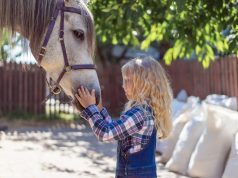Katherine Marraccini is a practicing veterinarian and animal advocate. In the following article, Katherine explains zoonotic diseases, how they spread, and how pet owners can protect themselves, their families, and their pets from contracting these oftentimes fatal illnesses.
We love our pets, but no one likes the thought of having to worry about diseases that can be transmitted between humans and animals. After all, keeping a small child from contagion is hard enough; supervising a cat or dog the same way is overwhelming! Katherine Marraccini explains that, as a veterinarian, she is often asked what steps should be taken for preventing spread from zoonotic diseases.
Zoonotic diseases, or the type of disease that can be spread from vertebrate animals to human beings, can be prevented by observing correct personal hygiene, maintaining the environment, and remaining vigilant in the life of oneself and one’s pets.
In this article, Katherine Marraccini examines the four steps it takes to prevent the spread of zoonotic disease, both for the safety of communities and their beloved furry friends. By the conclusion, readers should have peace of mind not only about what zoonotic diseases actually are, but how to keep them from endangering people and animals.
Steps to Protect and Prevent
Katherine Marraccini explains that protection is all about preparedness. Being proactive instead of reactive is the best way to fight any danger, especially contagious disease. Zoonotic diseases are no exception to this rule; however, understanding where to start can be a daunting task.
Because of this, Katherine Marraccini prepared a quick list of the main steps that can be taken to protect pets and their owners from zoonotic disease. Observe that list below:
- Understand What Zoonotic Disease Is
- Observe Correct Personal Hygiene
- Maintain the Environment
- Stay Vigilant
Katherine Marraccini discusses each of these steps further just to be sure that zoonotic diseases are being fought not only with actions, but understanding.
Understanding Zoonotic Disease
The first step to battling an enemy, even when that enemy is a contagious disease, is understanding it. According to the Brittanica Encyclopedia, “zoonotic disease” can also be called “zoonosis.”
Basically, these diseases are any kind of illness in the groupings that can be transferred from an animal that is not a non-vertebrate to a human being. Unfortunately, Katherine Marraccini explains that this includes just about all of the animals commonly taken in as pets or farm companions, such as cats, dogs, livestock, ambphibians, and even fish.
Some of these diseases can include bacterial infection, viruses, fungi, and even parasites. One of the worst dangers of zoonotic disease is that they typically cannot be controlled or wiped out by vaccinating the humans who carry the contagion. Instead, Katherine says that prevention is much more worthwhile as a safety measure.

Observe Correct Personal Hygiene
Personal hygiene is one of the first lines of defense against any disease, but especially animal-transmitted diseases. Make sure to always wash hands after handling animals, but also perform this task before handling them, too.
Katherine Marraccini says that some pet owners like to share food or even drinks with their animals, but unfortunately, this is one of the most dangerous ways to get a transmittable bacteria or parasite. Instead, keep eating and drinking around animals to a minimum.
It is particularly important that any animal which may be sick should only be handled with gloves. Additionally, a human being who is sick should avoid contact or even entrance to an animal’s main living area if at all possible.
Maintain the Environment
Katherine Marraccini says that another way to combat these contagious diseases is to keep the living space of oneself and one’s pets clean and tidy. If any traces of fecal matter, urine, or even dander begin to build up, infection can spread like wildfire undetected.
Frequent cleaning of bedding and eating receptacles should be performed, and always while wearing gloves for the best safety results.
Stay Vigilant
Finally, vigilance is the best preventative measure according to Katherine Marraccini. Pet owners should be carefully aware of the health of their pets. Watch out for the little things, such as immobility or a hard time breathing, and especially pay attention to whether or not stool is solid. Remember to take sick animals to a veterinary professional as soon as any of the above-mentioned symptoms are noticed.
In Conclusion
In summary, zoonotic diseases are infectious diseases that can be spread to humans from vertebrate animals, which can include most of the animals owned as pets.
To prevent infection that can endanger both a pet and the pet’s owner, Katherine Marraccini suggests to keep hands washed and refrain from sharing any kind of food or water with pets. Ensure that vigilance is always constant, both in observing the animals and making sure the cleanliness of the environment is consistent. When these steps are taken, there is little to fear from zoonotic disease!









